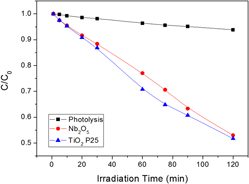Crossref Citations
This article has been cited by the following publications. This list is generated based on data provided by
Crossref.
Falk, G.S.
Borlaf, M.
López-Muñoz, M.J.
Rodrigues Neto, J.B.
and
Moreno, R.
2018.
Photocatalytic activity of nanocrystalline TiNb2O7 obtained by a colloidal sol-gel route.
Ceramics International,
Vol. 44,
Issue. 6,
p.
7122.
Jaramillo-Páez, C.
Sánchez-Fernández, F.J.
Navío, J.A.
and
Hidalgo, M.C.
2018.
Photo-induced processes on Nb 2 O 5 synthesized by different procedures.
Journal of Photochemistry and Photobiology A: Chemistry,
Vol. 359,
Issue. ,
p.
40.
Ücker, Cátia L.
Gularte, Luciano T.
Fernandes, Cristian D.
Goetzke, Vitor
Moreira, Eduardo Ceretta
Raubach, Cristiane W.
Moreira, Mario L.
and
Cava, Sergio S.
2019.
Investigation of the properties of niobium pentoxide for use in dye‐sensitized solar cells.
Journal of the American Ceramic Society,
Vol. 102,
Issue. 4,
p.
1884.
Han, Xianying
Russo, Patrícia A.
Goubard‐Bretesché, Nicolas
Patanè, Salvatore
Santangelo, Saveria
Zhang, Rui
and
Pinna, Nicola
2019.
Exploiting the Condensation Reactions of Acetophenone to Engineer Carbon‐Encapsulated Nb2O5 Nanocrystals for High‐Performance Li and Na Energy Storage Systems.
Advanced Energy Materials,
Vol. 9,
Issue. 42,
Falk, Gilberto S.
Rodrigues Neto, João B.
Borlaf, Mario
Gómez, Sergio Y.
Novaes de Oliveira, Antonio P.
and
Hotza, Dachamir
2019.
Fast microwave‐assisted hydrothermal synthesis of TiNb2O7 nanoparticles.
International Journal of Ceramic Engineering & Science,
Vol. 1,
Issue. 4,
p.
235.
Marins, Natália Hadler
Lee, Bryan E.J.
e Silva, Ricardo Marques
Raghavan, Arjun
Villarreal Carreño, Neftalí Lenin
and
Grandfield, Kathryn
2019.
Niobium pentoxide and hydroxyapatite particle loaded electrospun polycaprolactone/gelatin membranes for bone tissue engineering.
Colloids and Surfaces B: Biointerfaces,
Vol. 182,
Issue. ,
p.
110386.
Silva, Ricardo M.
Noremberg, Bruno S.
Marins, Natália H.
Milne, Jordan
Zhitomirsky, Igor
and
Carreño, Neftalí L.V.
2019.
Microwave-assisted hydrothermal synthesis and electrochemical characterization of niobium pentoxide/carbon nanotubes composites.
Journal of Materials Research,
Vol. 34,
Issue. 4,
p.
592.
Nishimoto, Shunsuke
Takiguchi, Takahiro
Kameshima, Yoshikazu
and
Miyake, Michihiro
2019.
Underwater superoleophobicity of Nb2O5 photocatalyst surface.
Chemical Physics Letters,
Vol. 726,
Issue. ,
p.
34.
Memari, Mohammad
and
Memarian, Nafiseh
2020.
Designed structure of bilayer TiO2–Nb2O5 photoanode for increasing the performance of dye-sensitized solar cells.
Journal of Materials Science: Materials in Electronics,
Vol. 31,
Issue. 3,
p.
2298.
Han, Xianying
Russo, Patrícia A.
Triolo, Claudia
Santangelo, Saveria
Goubard‐Bretesché, Nicolas
and
Pinna, Nicola
2020.
Comparing the Performance of Nb2O5 Composites with Reduced Graphene Oxide and Amorphous Carbon in Li‐ and Na‐Ion Electrochemical Storage Devices.
ChemElectroChem,
Vol. 7,
Issue. 7,
p.
1689.
Ruwer, Thais Lemes
Venturini, Janio
Khan, Sherdil
and
Bergmann, Carlos P.
2020.
Quick synthesis of homogeneous Nb2O5 nanorod arrays via a microwave-assisted hydrothermal method.
Materials Letters,
Vol. 265,
Issue. ,
p.
127429.
Marins, Natália H.
Silva, Ricardo M.
Ferrua, Camila P.
Łukowiec, Dariusz
Barbosa, Ananda M.
Ribeiro, Juliana S.
Nedel, Fernanda
Zavareze, Elessandra R.
Tański, Tomasz
and
Carreño, Neftalí L. V.
2020.
Fabrication of electrospun poly(lactic acid) nanoporous membrane loaded with niobium pentoxide nanoparticles as a potential scaffold for biomaterial applications.
Journal of Biomedical Materials Research Part B: Applied Biomaterials,
Vol. 108,
Issue. 4,
p.
1559.
Park, Jong Chel
Park, Sangbaek
and
Kim, Dong-Wan
2020.
High-power lithium-ion capacitor using orthorhombic Nb2O5 nanotubes enabled by cellulose-based electrospun scaffolds.
Cellulose,
Vol. 27,
Issue. 17,
p.
9991.
Kumari, Neha
Gaurav, Kumar
Samdarshi, S.K.
Bhattacharyya, A.S.
Paul, Samrat
Rajbongshi, BijuMani
and
Mohanty, Kaustubha
2020.
Dependence of photoactivity of niobium pentoxide (Nb2O5) on crystalline phase and electrokinetic potential of the hydrocolloid.
Solar Energy Materials and Solar Cells,
Vol. 208,
Issue. ,
p.
110408.
de Moraes, Nicolas Perciani
Roupinha, Lais Helena Antonio
dos Santos, Gabriela Spirandelli
de Menezes, Beatriz Rossi Canuto
de Sousa, Juliana Giancoli Martins
Dantas, Gustavo Viégas Jucá
Chaguri, Lívia
and
Rodrigues, Liana Alvares
2020.
Synthesis, characterization and application of Nb2O5-doped zinc oxide for solar-based photodegradation of 4-chlorophenol.
Materials Letters,
Vol. 275,
Issue. ,
p.
128156.
Ücker, Cátia L.
Riemke, Fábio C.
de Andrade Neto, Nivaldo F.
Santiago, Anderson de A.G.
Siebeneichler, Tatiane J.
Carreño, Neftali L.V.
Moreira, Mario L.
Raubach, Cristiane W.
and
Cava, Sergio
2021.
Influence of Nb2O5 crystal structure on photocatalytic efficiency.
Chemical Physics Letters,
Vol. 764,
Issue. ,
p.
138271.
Su, Kaiyi
Liu, Huifang
Gao, Zhuyan
Fornasiero, Paolo
and
Wang, Feng
2021.
Nb2O5‐Based Photocatalysts.
Advanced Science,
Vol. 8,
Issue. 8,
Ücker, Cátia L.
Goetzke, Vitor
Riemke, Fábio C.
Vitale, Marcelo L.
de Andrade, Lucas R.Q.
Ücker, Maicon D.
Moreira, Eduardo C.
Moreira, Mário L.
Raubach, Cristiane W.
and
Cava, Sérgio S.
2021.
Multi-Photonic behavior of Nb2O5 and its correlation with synthetic methods.
Journal of Materials Science,
Vol. 56,
Issue. 13,
p.
7889.
Ambreen, Subia
Pandey, N. D.
Chouhan, Arti
Kumar, Hemaunt
and
Pandey, Ashutosh
2021.
Effect of chelation in alkoxide precursors of niobium oxide nanoparticles on photochemical degradation of rhodamine B.
Journal of Sol-Gel Science and Technology,
Vol. 98,
Issue. 2,
p.
319.
Ma, Xiaoming
Hao, Huimin
Sheng, Wenlong
Huang, Fengwei
and
Lang, Xianjun
2021.
Bridging green light photocatalysis over hierarchical Nb2O5 for the selective aerobic oxidation of sulfides.
Journal of Materials Chemistry A,
Vol. 9,
Issue. 4,
p.
2214.






